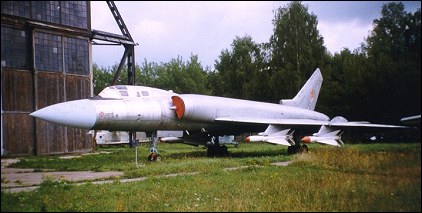|
| The largest and heaviest interceptor fighter ever to have achieved service status, the Tu-128 was developed by a team led by I. Nezval'. A dedicated interceptor fighter intended for the high-altitude patrol of sections of the Soviet periphery unprotected by surface-to-air missile screens, the Tu-128 was flown as a prototype (Tu-28-80) on 18 March 1961 powered by two TRD-31 (Lyulka AL-7) turbojets. Production deliveries to the Voyska PVO began in late 1966, the Tu-128 having a crew of two and paired AL-7F-2 turbojets each rated at 7425kg unaugmented and 10,000kg with afterburning. Equipped with a large I-band radar, the Tu-128 had a primary armament of two radar-homing and two infra-red homing Bisnovat R-4 missiles. Progressively withdrawn from the Voyska PVO home defence fighter force through the 'eighties, the Tu-128 was finally succeeded by the MiG-31 in late 1990.

| MODEL | Tu-28P |
| ENGINE | 2 x Lyulka AL-21F turbojets, 11200kg |
| WEIGHTS |
| Take-off weight | 40000 kg | 88185 lb |
| Loaded weight | 25960 kg | 57232 lb |
| DIMENSIONS |
| Wingspan | 18.1 m | 59 ft 5 in |
| Length | 27.2 m | 89 ft 3 in |
| PERFORMANCE |
| Max. speed | 1850 km/h | 1150 mph |
| Ceiling | 20000 m | 65600 ft |
| Range | 5000 km | 3107 miles |
 | A three-view drawing (1663 x 1237) |
| Vahe David Demirjian, e-mail, 22.08.2020 19:44 Many older books on Soviet aviation claim that the Tu-128 prototype was designated Tu-102. However, the Tu-102 designator was actually used for a 1950s Tupolev design for an assault transport powered by two Kuznetsov TV-2F turboprops, which never left the drawing boards. reply | | Barry, 04.04.2013 12:52 This aircraft was somewhat of a revolution in interceptor terms if not in overall aeroplane terms. The Russians were increasingly concerned about defending their northern and eastern boundaries and needed a plane that could cover the vast exposed areas from suspected attacks by the USAF. This incredibly large plane was developed with a greater range than any previous or subsequent interceptor. The problems lay in the piloting of such a craft. The PVO Obrana (Fighter Defense of the Homeland) selected pilots from their existing cadre of MiG 17 and 19 pilots who had been used to flying a very much lighter craft which used a stick rather than a wheel. Coupled to this was getting this very large and fast aeroplane off the ground required skills not usually assocciated with interceptor fighters. To the original group of selected pilots it seemed indefensible that no trainer had been built. Eventually after encountering many problems the powers that be arranged for the construction of four Tu128 UTI trainers and the conversion of a further six aircraft to the trainer role.
It was originaly intended to have 25 air regiments equipped with the Tu128 but in the event only some six were so equipped. Each regiment consiting of three squadrons of 9 to 12 aircraft each. The aeroplane was gradually withdrawn from use in the 1970's and 1980's and all bar two were cut up and scrapped throughout the 1990's. reply | | paul scott, e-mail, 12.07.2012 22:15 Still the largest interceptor aircraft ever built. reply | | guozhong, 20.06.2011 13:11 Progressively withdrawn from the Voyska PVO home defence fighter force through the 'eighties, the Tu-128 was finally succeeded by the MiG-31 in late 1990. reply | |
| | leo rudnicki, e-mail, 12.04.2009 07:02 Bisnovat R-4 missiles, Nato designation A-A 5 Ash ,were carried by the big Tupolev and no other. Missiles too, were long range. The range of this fighter may never be equalled. reply |
|
Do you have any comments?
|
| 
COMPANY
PROFILE
All the World's Rotorcraft
|








